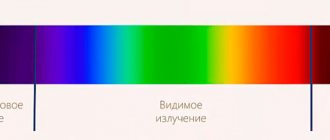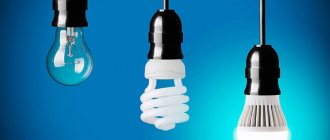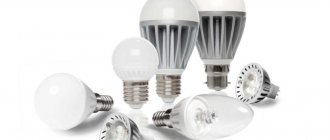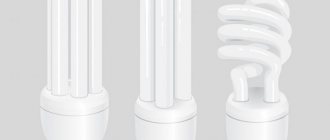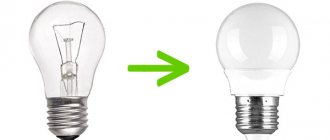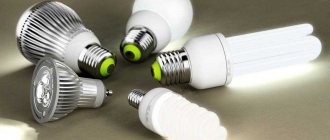LEDs have become a very popular light source in the last decade. They came to replace compact fluorescent lamps (CFLs) or, as they are popularly called, energy-saving lamps. Then the era of LED lighting for humans began.
Energy-saving lamps were relatively dangerous due to the mercury vapor contained in their bulb. If it is destroyed, there is a risk of serious harm to your health, even death. Let’s look at whether LED lamps are harmful to humans?
Sources of harm to health
To prove or disprove the harm of LED lamps to health, we will determine the sources of damage to the body. Let us conditionally divide them into 2 groups: device characteristics and improper operation.
Characteristics of a lighting device that are harmful to the body:
- Spectral characteristics of the light source;
- radiation in the infrared spectrum;
- pulsations of light flux.
The second group is harm to health not from the light source itself, but from its improper use. Let's look at each lighting factor that affects your health and determine whether LED light is harmful to your eyes.
Design of the Orion lamp
The Orion LED lamp has many position settings due to 4 moving elements. The angle of inclination of the element in which the LEDs are located also changes. Due to this, you will receive sufficient lighting at the required angle in any position. On the back wall there is a 5 Volt 1 Ampere USB charger socket.
What are the differences between light sources?
Sunlight should be taken as the standard, since it contains the most complete spectrum of light radiation. Of all the artificial lighting devices, the incandescent light bulb is the closest to the sun. Compare the spectral characteristics of different sources.
The graphs show different spectra of lighting fixtures. Incandescent light has a smooth spectrum, increasing towards the red region. The spectrum of fluorescent light sources is quite ragged, plus a low color rendering index (about 70).
Working in rooms with such lighting causes increased fatigue and headaches, as well as distorted color perception.
The spectrum of LED lamps is more complete and even. It has increased intensity in the wavelength region of 450 nm, for cold glow, and in the region of 600 nm, for “warm” lamps, respectively. LED sources provide normal color rendering with a CRI index of more than 80. LED lamps have extremely low ultraviolet radiation intensity .
If you compare the spectrum of diode and popular fluorescent lamps, it becomes clear why the latter are used less and less. The spectrum of CFLs is completely far from the standard, and their color rendering index leaves much to be desired.
Based on this, we can conclude that, based on the characteristics of the spectrum, LED lamps are harmless to health.
Stated characteristics
The Flora and Orion samples are represented by the Remez trademark from Romati LLC, which is a representative of the German manufacturer Remilicht GmBH. They use South Korean Sunlike LEDs, which provide lighting that is as close in spectrum to natural sunlight as possible, is safe for vision, does not disrupt hormonal levels, and has a high color rendering index.
| Parameter | Orion | Flora |
| Power | 10W | 8W |
| Light flow | 500lm | 470lm |
| Colorful temperature | 2700K – 6500K | 2700K – 6500K |
| Dimensions | 441 x 486 x 200 mm. | 465 x 480 x 130 mm. |
| Weight | 1.30 kg. | 0.97 kg. |
| Color rendering index CRI | >95 | >95 |
| Guarantee | 2 years | 2 years |
Power is supplied from an external power supply, this made it possible to minimize the size of tabletop LED lamps and place the high-voltage part further away from the table. If a child spills water while painting with paints, there will be no dangerous high voltage on the wetted surface.
Why do the lamps flicker?
The next factor that affects well-being is the pulsation coefficient of the light flux. To understand what it is and what it depends on, you need to consider the shape of the voltage in the electrical network.
The quality of light and its pulsation depend on the power source from which they operate. Light sources that operate on constant voltage, such as 12-volt LED lamps, do not flicker. Let's look at flickering and the harm of LED lamps to the eyes, the causes of their occurrence and ways to eliminate them.
From the outlet we receive alternating voltage with an effective value of 220V and 310V amplitude, which you can see in the top graph (a).
Since LEDs are powered by direct current, not alternating current, it needs to be rectified. The body of the LED lamp contains an electronic circuit with a single- or full-wave rectifier, after which the voltage becomes unipolar. It is constant in sign, but not in magnitude, i.e. pulsating from 0 to 310 volts, graph in the middle (b).
Such lamps pulsate at a frequency of 100 hertz or 100 times per second, in time with the voltage ripples. The harm to the eyes of LED lamps depends on their quality, more on this later.
Do the LEDs pulsate?
LED lamps use drivers with current stabilization (expensive), or anti-aliasing filters (cheap). The voltage becomes constant and stabilized if capacitive filters are used.
If the manufacturer has not saved on the driver, the current value becomes stable. This is the best option for both ripple reduction and LED lifespan.
The photo below shows what the pulsations look like from the camera's perspective. You may not notice the pulsation, since the organs of vision strive to adapt the picture for perception. The brain absorbs these pulsations perfectly, which causes fatigue and other side effects.
The effect of LED lamps on human vision can be negative if they produce a pulsating light flux. Sanitary standards limit the depth of pulsations for office premises to 20%, and for places where work is carried out causing eye strain to 15%.
Lamps with large pulsations should not be installed at home; they are only suitable for lighting the corridor, pantry, entrances and utility rooms. Any room where you do not do any visual work and do not stay for a long time.
The harm from low-price LED lamps is caused primarily by pulsations. Don’t skimp on lighting; an LED with a normal driver costs only 50-100 rubles more than the cheapest Chinese analogues.
Other light sources and their pulsations
Incandescent lamps do not flicker because they operate on alternating current and the filament does not have time to cool down when the voltage crosses the zero mark. Fluorescent tubular lamps flicker if connected using the old “throttle” circuit. You can distinguish it by the characteristic throttle hum during operation. The photo below shows the pulsations of a raster lamp as seen by the phone camera.
More modern CFLs and LLs do not hum or flicker only because their circuit uses a high-frequency switching power supply. Such a power source is called an electronic ballast (electronic ballast or device) .
How to fix a cheap, low quality module
It should be noted that cheap lamps of Chinese origin are equipped with a low-quality voltage conversion module. Instead of a driver, a transformerless power supply with a capacitor having polarity is installed there. It serves to reduce the variable component to zero. But the small capacity does not allow one to cope with the task one hundred percent, and does not fully perform its function. The pulsation coefficient can be 60%. The quality of light decreases and can dramatically impair vision and affect health safety.
Experts advise replacing this type of capacitor with a similar one with a capacity of 470 μF, if the dimensions of the lamp body allow.
Replacing a capacitor to reduce ripple factor
Harm from the infrared spectrum
To determine whether LED lamps are harmful to vision, consider the third factor of harm - infrared radiation. It is worth noting that:
- Firstly, the harmfulness of the IR spectrum is doubtful and does not have a solid argument;
- secondly, in the spectrum of LEDs, infrared radiation is either absent or extremely small. You can verify this in the graphs given at the beginning of the article.
Are halogen lamps harmful to health? In light sources rich in the infrared spectrum (halogens), responsible manufacturers (Philips, Osram, etc.) use IR filters, so their harm to health is minimized.
Flora lamp design
The Flora table lamp has a base in the shape of a flower pot, in which you can place stationery. The large green LED mounting stalk is fully flexible and movable. A small translucent sheet works as a night light. At the base of the sheet there is an LED that illuminates the sheet from the inside.
Blue spectrum harm
It has been scientifically proven that radiation in the blue spectrum reduces the production of the sleep hormone melatonin and damages the retina, causing irreversible changes in it.
In addition to a drop in melatonin levels, blue light radiation causes a number of side effects: fatigue, increased eyestrain, eye disease. This color is perceived as brighter, which is often used in marketing to attract our attention. Most indicators on speakers, TVs, monitors, and other equipment are blue.
More details about this and how safe LED lamps are for the eyes are written in the community.
White LEDs are blue LEDs coated with a special phosphor that converts the radiation to white.
Blue color is the most negative factor in the influence of LED lamps on vision. Take a look at the graphs, namely the emission spectrum of the LEDs presented above. Even a warm-light LED lamp has a brightness peak in the blue spectrum, while a cold lamp has a very high brightness peak.
The practical side of the problem
So the harm of LED lamps to humans is not a myth? Not certainly in that way. The fact is that the studies were carried out under conditions where the samples under study were illuminated with powerful blue LEDs and their entire spectrum was in the “harmful” range.
Although there is a share of blue light in cold LEDs, it is no less in sunlight.
Modern people of any age spend a lot of time in front of computer screens, smartphones and tablets. Continuous focusing at a distance of 0.3-1 meter from the screen causes incomparably greater damage to vision.
The harmfulness of the blue spectrum of LED lamps, compared to the harm from device screens, is insignificant. LED is ideal for illuminating a room, office or other premises with a stream of bright light with low energy consumption.
If you are worried, various types of lenses and glasses for computer work have been developed to reduce the harm of blue radiation. Their filters reflect light in the blue range and make colors warmer.
You need to remember : it is not LEDs that are harmful to human health, but the incorrect mode of working with gadgets and poor lighting.
Effect on the human body
Effect on vision
As mentioned above, an LED light bulb emits a blue light wave. Repeated experiments have confirmed that the closer the radiation is to ultraviolet (blue and violet), the more stress our eyes experience. They generally do not tolerate light waves of this length very well. Therefore, a scale of phototoxicity has been introduced for artificial light sources, from infrared (the most comfortable) to ultraviolet (the most uncomfortable).
In accordance with this scale, 4 degrees of risk are classified, from zero (safe for health) to fourth (the most dangerous), depending on the time of exposure. Tests of various samples of LED lamps have shown that they can be classified, depending on the technologies used, as first or second degree (low or moderate risk).
This is why it is so important to carefully choose the manufacturer of LED lamps when purchasing.
Melatonin production
Melatonin is the main hormone responsible for regulating circadian rhythms in the human body. In addition, it has a powerful antioxidant effect and has a beneficial effect on the immune system. Disruption of its production can lead to various psychological disorders, and in some cases to more severe consequences: diabetes, problems with the cardiovascular system, obesity and even cancer. In principle, light of any spectrum can suppress its secretion. But blue light has the biggest impact.
One should also take into account the fact that the harmfulness of the influence increases from exposure to any light on a person at a time when we should be in the dark, for example, late in the evening or at night.
Therefore, in places intended for sleeping, it is recommended to replace LED light bulbs with regular ones, preferably of a dim color.
LEDs - benefit or harm?
You can understand whether LED lamps are harmful or not by organizing proper lighting in accordance with GOST on lighting. It regulates the amount of light to carry out work of varying precision and size of parts that you operate with during work.
LED light sources allow you to achieve the desired brightness in the workplace, with minimal electricity bills. You will preserve your vision, it will be easier for you to work when the room is light and you don’t need to look at small details in dim light. In this case, the harmfulness of LED lamps to the eyes is minimal.
The high energy consumption of old incandescent lamps is unprofitable both on a national scale (high load on power lines) and on an individual scale (high consumption and high price of electricity).
Today, the debate about whether LED lamps are harmful to vision remains open and a definite answer cannot be given. They have filled the lighting market relatively recently, less than 10 years ago, and many are skeptical about them.
The impact of LED lamps on human health will be zero if the daily routine, sleep and work are followed correctly. If a person is subject to stress, excessive loads and does not take the quality of sleep seriously, no light source will preserve his health.
If you have personal experience, a link to an interesting source, or you want to talk about the dangers of diode lamps, share in the comments.
Illumination
The samples are heated for 1 hour until the parameters stabilize. We measure the illumination on the desktop at minimum and maximum brightness using a lux meter. According to standards, the lighting level of the workplace must be at least 300 lux. This indicator applies to performing small tasks, reading, drawing and other types.
| Level | Orion | Flora |
| Minimal, luxury | 610lux | 520lux |
| Maximum, lux | 1320lux | 970lux |
The measurement results showed maximum illumination of up to 1320 and 970 lux, respectively, which is sufficient for any precision work.
The benefits of LED in everyday life
In addition to household applications, you can save on artificial greenhouse lighting. The range of LEDs for phytolamps allows your crops to grow faster and better. For this purpose, HPS lamps are often used, the light of which contains different wavelengths.
The power of such light sources is calculated at hundreds of watts, while LED phytolamps have a power ten times less and contain only the necessary wavelengths for better plant growth.
Although prices have decreased by about 10 times from 2011 to 2022, the price of one LED lamp equivalent to 100 W incandescent remains at the level of 10 incandescent lamps, which stops many consumers from making a purchase.
For the environment, abandoning gas-discharge lamps is an absolute plus; we wrote about this in an article about waste of LED products. But what danger LED lamps pose to health is not yet fully known. What is clear is that there is no longer any fear of mercury vapor.
The use of new light sources by a wide range of people allows developers to receive finance for new, more advanced projects. And technological progress is always moving forward. Therefore, we need to wait for statistics, then it will become clear how much harm LED lamps cause to health, and this takes time.
Please rate the article. We tried our best:)
Did you like the article? Tell us about her! You will help us a lot :)
Content of harmful substances
Unlike energy-saving lamps, LED light bulbs do not contain any environmentally harmful components, poisonous gases or mercury.
What it consists of is:
- plastic
- steel
- aluminum
- electronic driver components
They have a 4th hazard class, that is, in fact they are equated to household waste.
Just be careful with so-called “smart” light bulbs. There is a hidden threat in them.
Which one exactly, read in a separate article.
Consumer Reviews
I decided to make repairs and at the same time change the light bulbs to LED ones to save money. However, they are not cheap and cost approximately 10 times more than regular ones. I decided to test this savings first and bought 7 units. I chose the power as indicated. The chandeliers had 75-watt lamps and I bought analogues with a power of 9 and 12 watts. I changed all the light bulbs, turned them on - the illumination is similar, i.e. actually the same. Now the fun part: before installing the LEDs, I measured the electricity consumption with ordinary light bulbs. At the same time, all other consumers were turned off. Later I screwed LEDs into two chandeliers and went to measure them on the meter. According to measurements, it turned out that the counter rotates approximately 7 times slower. It turns out that saving is true.
Ivan Yablunovsky, Moscow
I heard that LED lighting devices are all the same and they are made in almost the same factory in China. That is, why pay more for a brand. Although there are many Russian devices that are lower in cost, they are not cheap. As a result, I ordered 10 diode lamps of 8 watts each from China. We arrived in 3 weeks. They all work, but not in the same way, which already suggests poor quality. I decided to measure the pulsation - it turned out to be about 90%. A good sign is 10-20%. This means the power circuit is not high quality and will not last long. It is difficult to draw conclusions based on one example, but it is better to take proven light bulbs with a guarantee.
Sergey Dobrolyubov, Novosibirsk
At the dacha in the summer we decided to make a suspended ceiling. We conducted an experiment and built LEDs into the ceiling. I took powerful light bulbs - 13 watts. They decided to install 15 lamps on an area of 35 meters. We were afraid that it would not be bright, since the power of the lamps is 13 watts, which gives a total of 195 watts. I understood that they should be more effective, but not as much as it turned out. In general, I was afraid that everything needed to be changed. It’s good that I provided in advance for switching on different groups of lamps on different switches.
Alexander Dorofeev, Salekhard
Electromagnetic radiation
Drivers of LED lighting sources generate high-frequency pulses, creating electromagnetic interference in the surrounding area.
This fact may affect the operation of some electronic devices: radios, televisions, WI-FI transmitters. It is important to locate these devices no closer than 40 cm from the source of interference.
The harm from electromagnetic radiation from an LED lamp is much less than the harm from a mobile phone. The danger that arises is insignificant for humans and can be neglected.
general description
LEDs are high-brightness electronic components that are very small in size but emit a large amount of light. Because the tiny dot is so bright, it unfortunately causes a lot of glare, which is hard on your eyes. Therefore, it is better to use LED sources in which the light is scattered by additional optics or emitted by several LEDs of lower brightness instead of one diode with a very high power.
Glow principles
LEDs are semiconductor crystals that begin to glow when current passes through them. Each crystal emits rays of its own spectrum (red, yellow, green). White light is produced by mixing these spectra or coating the brightest blue LED with a layer of yellow coating. By changing the color ratio, you can get either cold or warm light.
Common LED devices include:
- plastic white or colored flask;
- charging;
- AC rectifier driver (board);
- radiator;
- base;
- lower and upper holder.
Lighting fixtures come in various shapes and sizes. The price of LEDs depends on the required luminous flux and power consumption.
History of invention
The first information about diodes dates back to the 1920s. It was then that the Soviet technician Oleg Vladimirovich Lozev drew attention to the phenomenon of light emission in diodes with blades used in radio receivers.
Electroluminescence was discovered in the early twentieth century in Great Britain. Both discoveries, however, were not put to use until the 1960s, when General Electric took further development and released the red LED.
Initially, LEDs were very expensive. It was not until 1968 that commercial production began. Diodes were then used as signal elements, for example in electronic devices.
It was not until the 1990s that the first diode was created. Low power consumption, exceptional durability, and versatility of use are just some of the advantages of LEDs.
Another breakthrough in LED technology occurred in 2014, when the Nobel Prize in Physics was awarded to I. Akasaki, H. Amano and Sh. Nakamura for the invention of an efficient blue LED. Their invention made it possible to produce bright and energy-saving white light sources. The blue light diode developed by the scientists was necessary to create white light LEDs, which are increasingly used not only indoors, but are also becoming the main source of light in many other areas.

